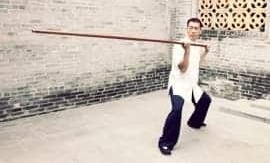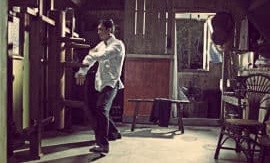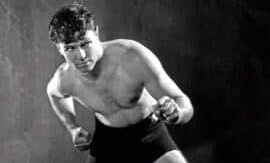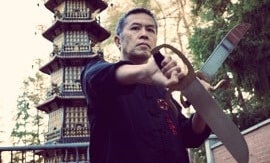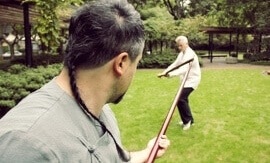
MARK HOBBS PROBABLY HAS MORE ACTIVE FIGHTERS IN THE CAGE THAN ANY OTHER WING CHUN SCHOOL AND EVEN MORE THAN MOST UK MMA CLUBS. MARK’S STUDENTS REGULARLY COMPETE IN PROFESSIONAL AND AMATEUR MMA, BOXING, K1, MUAY THAI AND BRAZILIAN JIU-JITSU COMPETITIONS, WHICH SURELY MAKES HIM A LEADING AUTHORITY ON HOW TO GET WING CHUN WORKING IN THE CAGE.
This is a fascinating and controversial subject, as this is an area where most Wing Chun practitioners have had very little success. What makes Sifu Hobbs’ approach different? Why is his Fight Team so successful? We wanted to find out, so we “cornered” him.
I’m aware you are busy putting your fight show Fusion together for March 5th, so thanks for taking time out to talk to us.
No problem, and thanks for asking me to talk about this subject. Since you have asked me to write an article for the next issue, I thought I’d give you a brief overview and some background in this interview, and in the article, I will go on to explain how we use our Wing Chun and keep it functional in MMA. There will be lots of technical information about the system we use; I’ll cover areas such as Rooting, Balance, Teng, Internal Power, Spiral Flow, Spiral Force, Structured Flow, Spiral Energy, Bridging Control, Pull Push and much more.
Sounds great. So tell me, how did you start your martial art journey?
When I was young, I started learning the discipline of Judo, which I still train today. This was the start of a life-long passion for the martial arts, including my love for Wing Chun. I have learnt and trained Wing Chun with a lot of people, but my teachers would be Lun Gai, who was Ip Man’s first student in Foshan, China, and Hung Nguyen, who was a student of Vu Ba Quy in the Vietnamese Yuen Chai Wan Wing Chun lineage from Fung Siu Ching.
Being a martial arts geek, I want to know the workings of everything, so at every stage, I always believed there must be more to learn and more to understand. This led me to train in Tai Chi, Hsing Yi Ch’uan and Pak Mei. I trained with some very renowned masters in these arts and tried to take whatever was useful and integrate it into my fighting. However, I found the power signatures in these arts didn’t mix, as each was different from Wing Chun’s engine. However, it wasn’t wasted time—I still enjoyed learning about them, and the experience helped me to understand the beauty of the Wing Chun approach.
I must also give recognition to Shaolin Ancestor Fist, and a close friend and training partner of mine, Siukee Wan. We have discovered so many truths within Teng Sau Chi Sau together over the years.
Given that Judo was my first martial art, I’ve always been interested in the sport combat arts, and my constant desire to understand more led me to learn more combat sports, such as Western Boxing and Muay Thai, coupled with freestyle Wrestling and Brazilian Jiu-Jitsu, which I now train and teach under my good friend and professor, Ricardo da Silva. Inevitably, when you have such a breadth of experience, you can’t help but want to mix up and link the different disciplines and skillsets to develop a coherent method of MMA.
Can you tell us more about how you got into MMA?
I love Wing Chun and I was frustrated by the shortage of quality Wing Chun equipment available in Europe. I saw an opportunity to provide top quality, reasonably priced equipment for everyone to use, and my company Pagoda Imports has now been doing that for over 15 years.
I had a similar idea for MMA and created a fight wear brand, but I didn’t enjoy this angle of business within MMA, so subsequently I sold it. It meant, however, that I ended up with lots of contacts in the MMA industry.
Next, I started a Boxing promotion with my business partner, Ross Minter. It became very successful, but Boxing wasn’t for me; I find it too one-dimensional. Being a Mixed Martial Artist, I wanted to own an MMA promotion, not a Boxing promotion, so I left Queensbury Boxing League and started up Fusion Fighting Championship with Ricardo da Silva, my current business partner. Fusion Fighting is now one of the biggest events on the MMA calendar in the UK, and I love it!
How about your gym and team? Tell us more about that.
My gym is Kinetics Fight Academy. It’s a full-time professional gym, with a variety of classes running all week as well as private lessons during each day. We all train hard in each of the disciplines that make up MMA, namely striking, takedowns and groundwork. The fighters also do strength and conditioning on top of all their skills work. It’s hard, intensive training!
The fact I have a full-time fighting gym and my guys compete at a professional level means I have no choice but to stay at the top of the game. I have to work hard; sparring with and developing my students and fighters in all aspects of their training in order to give them the skills they need to win.
This is great, but what makes your MMA different from other MMA schools?
The answer is simple: understanding Wing Chun is what makes us different from every other MMA club. Wing Chun is our core engine. It drives all the stand-up skills I teach my guys.
Okay, so what makes your Wing Chun different from other Wing Chun schools?
The opposite—MMA is what makes my Wing Chun different. Our skills are constantly tested under pressure against other skilled fighters in a modern battle arena, against many unpredictable variables. This means that our system of Wing Chun has to be able to cope with any attack from any range, including clinches and takedowns. This constant pressure testing is uncommon in the Wing Chun world.
What do you use for your ground fighting approach, as this is a big part of MMA?
I use Brazilian Jiu-Jitsu. BJJ is built upon the principle of levers, so it fits perfectly with the understanding of kinetics in our stand-up fighting system, underpinned by its Wing Chun core. There’s a saying in Jiu-Jitsu: “position before submission”. A different expression of the same principle is “control before strike”, and this mantra lies at the heart of our stand-up fighting system. I’ll unpack exactly what I mean by this in next issue’s feature article, as I think this is what will be of greatest interest to the Wing Chun community.
Ground fighting is not so relevant to a Wing Chun audience, so let’s quickly discuss how you use Chi Sau in MMA and how you make it fit?
The simplest way to think about it is that if your opponent hasn’t got balance, he can’t start. Our approach is therefore about controlling the opponent first, before striking or taking them down. For this reason, Chi Sau requires BALANCE, TENG “LISTENING” and INTERNAL POWER to be effective. If we are going to control the arms (“Bridges”) first, we need to base (“Root”) ourselves, then we need to float our opponent. This can simply be a pull or a push, which will control their centre of balance.
A lot of Wing Chun styles use a linear structure with the elbows held in, which in an MMA environment wouldn’t be effective enough to cope with the range of attacks that are normally presented. We, therefore, require free-flowing, non-linear elbow movements, which are circular. This way, we can create the angles we need that are required for the bridge control.
Our Wing Chun system relies on Spiral Flow as the method of attack and defence. This flow is Internal and the type of power that is generated is known as Spiral Force. Spiral Flow is unique in that it distorts while penetrating and is, therefore, a very effective method by which we can control the opponent.
Thanks Mark, we look forward to finding out more about how your system works in your article for the next issue.
No worries, I looking forward to sharing and thanks for the interview, it was my pleasure.



